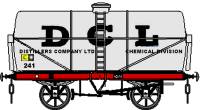
| < Return to index page |
Petroleum Products - Refining and Distribution Companies and Specialist Suppliers
To assist the modeller in providing a consistent and (more or less) prototypical appearance to their tanker fleets it is necessary to have some understanding of the oil industry itself. This can further be broken down into firms providing specialist services and the general oil companies. It should be noted that there was some inter-refinery traffic, one company might buy some product from another to create a required mix or to cover whilst plant maintenance was carried out. Hence just because you have modelled an Esso refinery you might also see other oil company tank wagons visiting the site. In the main however a refinery deals primarily with the traffic of the owning company. Customers would be more likely to obtain supplies from a distribution depot than direct from the refinery, although this did (and presumably still does)happen.
Petrol Additives
Petrol has long been associated with firms producing 'additives', up to the 1950s carburine, benzene and benzole (all recovered from coal tar) and several firms (notably Cleveland Petrol) added alcohol to their petrol. The coal tar based additives were originally sold as a fuel in their own right but motorists found they worked better mixed with petrol, adding the benzole reduced the problems of 'knocking' in the engine (which was finally 'solved' by adding tetra ethyl lead or TEL from the mid 1920s, but the use of benzole continued into the 1950s).
Cleveland was not unusual in using alcohol, the Cities Service Oil Co 'Citex Koolmotor' alcohol blend spirit had about 25 percent alcohol in the mix in the mid 1930s. Cleveland's alcohol was mainly supplied by the Distillers Company, the Cleveland 'Discol' brand was a contraction of Distillers Company alcohol. Esso bought into Cleveland during the later 1930s and obtained a controlling interest just after the war (although the brand was still used) and National Benzole was taken over by BP in 1957 (although again the brand remained in use). From the mid 1950s the use of coal tar additives declined, finally ending (I believe) in the 1960s)
Companies providing additives (and who used rail transport) include:
British Refined Motor Spirit Co.
This company, based in Bristol, sold benzole from 1903. The parent company (Butlers, see below under Oil Companies) definitely operated some rail tank wagons but I have not found a reference to benzole tanks (which would be Class A). I am not sure when they ceased trading under this name but in 1952 the parent company went into partnership with the local gas board to set up Bristol & West Tar Distillers, this in turn was bought by British Steel in 1970, regarding both of which see 'Lineside Industries - Coal Tar and Wood Tar Distillers'. By 1965 Butlers had moved their own operation to their oil products plant centered on the new Rockingham Works at Avonmouth, where they operated under the name of Butlers Chemicals Ltd., but I believe they only used road transport.
British Benzol and Coal Distillation Ltd
This company was set up in 1929 as a joint venture between Bedwas colliery and various investors. Based at the Bedwas coal mine in Monmouthshire they built a large coke plant, selling the coke to steel works, the gas to local towns and processing the by-products themselves. By 1930 they operated at least one Class B 14 ton tank wagon. This business shut down in about 1985 as the demand for coke (its principal product) had ceased with the closure of the steel works. A firm trading under the same name operated some petrol stations in either 1960s or 70s and from the 1970s there was a nation wide association of domestic heating oil suppliers trading under the name, however I do not think these were connected to the original Bedwas operation (I could be wrong). The heating oil suppliers business was bought by Total Butlers in 2005.
Newcastle Benzole Co
This company was based at Priestman Ottovale Coke and Tar Works (part of the Priestman Collierys organisation), they are particularly worthy of note as they are claimed to be the first in the world to produce petrol from coal, known as Blaydon Benzole. The works replaced an older firm 'Blaydon Burn Coke Ovens' of 19th century origin in about 1930. They operated some Class A tanks in their livery, the company name above the red band and Blaydon on Tyne below. See also 'Oil from Coal and Other Synthetic Fuels' above..
Benzole Producers Ltd
I was not able to find this companies history, they had branches all over the country in the later 1960s (many associated with gas works), and the the Government run Gas Council had a 2 percent stake in all of them in the mid 1960s. They built some branded Class A rail tank wagons in the early 1950s (these were still operating in the later 1960s), some of these were marked 'BENZENE' and others were marked 'BENZOLE' and the numbers were in the 800s and 900s. This organisation may have been connected with National Benzole but I am not at all sure of that.
Distillers Company Limited (DCL)
Formed in 1866 by a groupd of Scottish wiskey distillers, they provided the alcohol for Cleveland petrol, the Discol brand in the Cleveland range was a contraction of Distillers Company Alcohol. I have not yet traced any photographs of the rolling stock used, they may have employed hired wagons or possibly wagons supplied from Cleveland's fleet but DCL did I believe operate Class A wagons (the sketch below is based on a preserved wagon).

Fig : DCL Class A tank wagon
ICI
ICI supplied benzole to Cleveland for blending with their petrol, they may also have supplied other firms.
Associated Octel
This company set up a plant in Cheshire in 1940 to make TEL (tetra ethyl lead) for use as an anti-knock agent in petrol, for which they have used a number of 'demountable' tanks (transported on railway company owned 'conflat' wagons) as well as rather some 'continental' looking rail tank wagons. This company used an octagonal logo on some containers and their tank wagons which is difficult to replicate. Early examples were orange, by the early 1960 they were blue on a white background but as the tanks were generally rather clean. The logo was only used on some of the demountable tanks, these were basically a vertical cylinder and hence not too difficult to model. They were white so a printed wrapper made on a computer could be used (these tanks also had a large orange and black data panel on the side which would be near impossible to do by hand in N). The horizontal type were dove grey, see also 'Livery - Tank Wagons', and hence not difficult to model (the tanks from the W&T twin-gas tank kit make a fair starting point). Some of these tanks were carried on standard BR conflat wagons (I think some had purpose built chassis, still owned by BR, but these may just have been older pre-nationalisation container flats).
James Cosgrove & Sons
This company also supplied TEL from their Warrington works. Their tanks were slightly different, having rather more clutter on the top and the Fleetline 'sulphuric acid' tank might serve as the basis, see also 'Livery - Tank Wagons'. The small white lettering on the sides of the turquoise tank would be difficult (having said which they get very dirty very quickly so some serious weathering can cover up any messy bits). These tanks were supplied on purpose built chassis I believe, so the standard Peco chassis as recommended in the kit can be used.
Chemicals Used by Refineries
Phosphoric acid is an important industrial chemical, it was discovered in the 1850's and has been produced in considerable quantity. Phosphoric acid is used in a range of processes (see 'Lineside Industries- Chemicals') including petrol additives. It is often shipped as a clear liquid in specially lined tank wagons and drums (it attacks iron based metals and eats through glass) but in its pure form it is a solid transparent crystalline material originally shipped in jute bags but these days in lined steel drums. Peco offer a tank wagon in Albright & Wilson livery lettered for carrying phosphoric acid, this company was the market leader in this product. The model can be used on layouts from the mid 60s (when the tank type was introduced) until 2000 or shortly thereafter (when A&W was bought out by the French firm Rhodia). Note that phosphoric acid tanks are usually heavily stained with white in service.
Crude soda ash is a greyish white powder and has many uses in industry. The railways have supplied rolling stock reserved for this traffic since at least the 1920's and BR reserved and branded some of their COVHOP wagons and the open sand wagons fitted with two door restraining bars and a sheet supporter specifically for this traffic.
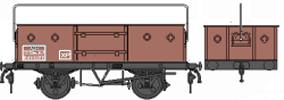
Fig : BR soda ash wagon
Caustic Soda (sodium hydroxide, sometimes called Lye) is a strong bleaching agent, requiring some care in handling. It is commonly supplied mixed with water and delivered in tank wagons to larger users, and is also supplied as white pellets in 10 lb cans. I believe some of the tank wagons used for caustic soda in the pre world war two era may have been of the 'hutched' type as shown below (although I am not certain on this).

Fig : Hutched chemicals tank
Oil Companies
For more on oil company branding see also Appendix One - Garages and Petrol Stations.
For details on Lubrication and other specialist oil suppliers see Lineside Industries - Lubricating Oils and Associated Works.
It is impractical to cover the details of all companies manufacturing or trading in oil products, a good start for anyone interested in these areas is Mr. R. Tourret's book 'Petroleum tank wagons of Britain' (see bibliography for details). There are rather a lot of companies called Standard Oil of somewhere, these were formed when the American giant Standard Oil Co was broken up in 1911 (after it was found to be a monopoly and was accused of price fixing and various other nefarious activities). The result was over thirty smaller companies, many of whom retained the word Standard in their title. There were a lot of British companies with 'oil' in their name, but many of these were vegetable or fish oil related industries. Examples include the Erith Oil Works who initially dealt in fish oils, later seed oils and the Kosmo-Lubric Oil Co of Stalybridge, Cheshire who were listed as oil importers and refiners in 1914, with a range of lubricants on offer, but on further investigation turned out to be dealing in vegetable oils. Seed crushing and its associated oil is discussed in 'Lineside Industries - Industries associated with docks'.
Where I was not able to trace a refinery operated by the company I have indicated this in the text, however although some firms bought their fuel from the oil companies others operated their own tank farms and imported the refined product (early examples being Power Petroleum and Russian Oil Products). Also companies sometimes went in and back out of the refinery business. Most of the firms listed below have at some point operated tank wagons several of which have been seen in model form.
In 1939 all the petroleum oil firms were taken into an arrangement known as the 'pool'. The oil and petrol companies formed one pool, lubricating oil firms formed another. During the war only a single grade of petrol was produced for civilian use, with quite a low octane rating (improved slightly in 1942). Petrol was not 'branded' during the war and no advertising was used. These arrangements continued until 1953, at which point the petrol companies resumed their advertising and gradually reintroduced their multiple grade distributions.
The UK oil industry was moderately stable until the 1960s, the listings below are divided into companies that operated in the UK before 1960 and those that appeared after that date.
Pre 1960s Brands
Carless
This was one of the first UK oil companies, formed in 1859 by Eugene Carless. Carless became the leading distillery in Britain for the newly imported American crude oil, and made advances in refining coal tar and shales, from which were derived benzolene, paraffin oil, burning naphtha and carburine. In 1872 a partnership with George Bligh Capel and John Hare Leonard brought a name change with the company trading as Carless, Capel and Leonard. Leonard became the sole proprietor within eighteen months. Following a merger with a nearby chemical firm run by a Frederick Simms (who was associated with Gottlieb Daimler) Simms suggested the trade name of Petrol, to be used for a motor launch spirit in 1893, and this was accepted by William Leonard. It was not however accepted for registration as a trade mark as it was regarded by the Registrar as a descriptive word. Marketing petrol firmly linked the firm with the motor car and Carless Capel and Leonard supplied their new fuel for the Emancipation Run to Brighton in 1896. Simms and Leonard were both founder members of the Automobile Club, later the R.A.C. At the turn of the century Carless Petrol was still virtually the only British source of highly refined motor spirit, and by 1906 the firm had 1,500 agents throughout the country. In 1909 or thereabouts they had tank wagons branded 'standard petrol' with the word 'Movil' in smaller lettering centrally below the filling dome above the Class A band with the company name below the band also in red. By the 1930s the branding was Caress petrol in red above the Class A band with the company name in black below the band and under that Petrol & Naphtha Distillers.
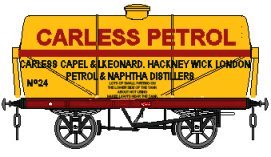
Fig : Carless 'Petrol' tank
The company developed the Coalite solid fuel in the 1920s and made TNT during the 39-45 war. The Company opened a new refinery at Harwich in 1964 taking on gas condensate from North Sea Oil. In 1965 a refining and storage depot was established at Longport, Staffordshire. With increasing demands for capital, Carless Capel and Leonard became a public company in 1971. Carless Petroleum was established as subsidiary in 1973, and Carless was also involved in on-shore fields at Humbly Grove and Wytch Farm. Production ceased at Hackney Wick in the early 1970s and the administration moved from the Hope Works to Petrol House, formerly a dry cleaning factory owned by Lush and Cook.The subsidiary Carless Solvents moved to Romford in 1984 and Carless Petroleum moved to Colchester in 1977. The parent company continued trading as Carless, Capel and Leonard Ltd from 1872 to 1989. In 1989 the Company was taken over and broken up and a new company, Carless Refining and Marketing, was established as a wholly owned subsidiary of Repsol at Romford, they specialised in the production of high quality solvents, oils and speciality products for industry. The company was a leading supplier of solvents to the printing ink industry for over forty years. By the early 21st Century Carless Refining and Marketing was owned by a Spanish firm. It was then bought and merged with a company called Petrochem, (formed in 1981) to become Petrochem Carless, since when wagons bearing the new company branding have been seen on the railways.
Young's Paraffin Light and Mineral Oil Company of Pumpherston
Pumpherston Oil Co. Ltd
Mid Calder Oil Co
Broxburn Oil Co
Clippens Oil Company of Paisley
Oakbank Oil Company of Midcalder
Caledonian Mineral Oil Co. Ltd., Cobbinshaw
Midlothian Oil Company of Straiton
These were all Scottish producers of Paraffin oils from mined shales. Paraffin (so named on account of its want of affinity with most chemical substances) was discovered more or less simultaneously by Reichenbach in Germany and by Dr Christison, of Edinburgh in about 1830. By the early 1830s people were experimenting with recovering this oil from shale deposits (up to this point these had been seen merely as colliery waste). In the 1840s a Manchester chemist by the name of James Young was asked to investigate oily deposits occurring in a coal mine at Alfreton, Derbyshire. He discovered that it contained small quantities of paraffin and set up a works to extract this material close by the mine. The process is more fully described above. Scotland's oil production began in the 1850s with James 'Paraffin' Young's first works producing oil from the coal-like Torbaneite mineral deposits near Bathgate. There was a shortage of oil (mainly for lamps) and the whale oil and vegetable oil industries could not meet the demand. Mr Young's new process seemed to have developed just at the right time, but the emergence of cheap American mineral oil reserves threatened the fledgling industry. A Midlothian pioneer William Young (no relation of James) further developed the process or refining shale and allowed Scotland's oil industry to survive.
Young's Paraffin Oil Co Ltd. was for a time the largest of the Scottish shale oil firms and also the only one to make and sell oil lamps. Young's Oil Coy Ltd were operating branded 10 ton tank wagons in 1902 (registered on the North British Rly) and built up a fleet of tank wagons. Young's was purchased by BP in 1919 but their liveries (they had several) probably survived for at least ten years or so (quite possibly longer - see Oakbank Oil Co below).
Oakbank Oil Co
These works opened in the mid 1860s (as the original shale oil patents expired). This company operated the first all-electrically powered Scottish mine in 1903. By the mid 1930s all the mines were operated by electricity and they even established their own local 'grid' to distribute power supplied by power stations at the retort works. The Oakbank company had an interest in high capacity tank wagons, including a six wheeler (rather similar to the 1930s milk tanks) and a couple of bogie tanks (they also operated a fleet of more conventional tanks). There are proper drawings in Mr Tourret's book on Petroleum Rail Tank Wagons (see Bibliography for details), the sketches below are mine and may well be wrong in detail. Oakbank's brand continued in use after the take-over by BP in 1919, they were still having wagons built and in their livery in 1940. The bogie tanks survived into BP ownership into the 1960s (again see Mr Tourret's book for details).

Fig : Oakbank tanks
The Pumpherston Oil Co
... was operating a 10 ton twin cylinder tank wagon in 1908, although the lettering on such small tanks would represent a challenge. Registered on the North British Railway this wagon was very similar in appearance to the N Gauge 'twin gas tank' wagon kit from W&T.
Broxburn Oil Co
... operated some sulphuric acid tanks and presumably also operated tankers for paraffin and liquid residues.

Fig : Scottish shale oil company logos
Scottish product names such as Smith's Royal Standard Lamp Oil, Sunlight Oil, and Taylor's Paraffine were all well known brands, Royal Standard Oil became (briefly) a worldwide brand (and many a Scot will tell you it may have prompted the choice of name in America of Standard Oil). The imported American lamp oils were cheaper but had a lower flashpoint which meant they were more likely to cause fires if spilled. In response to increasing public concern over deaths from oil lamp accidents, the Scottish oil producers campaigned to restrict competition from unsafe imported oils and highlighted the safety merits of their own products.
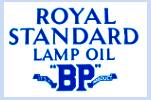
Fig : Royal Standard adverting plate (post 1919)
Scottish Oil Agency Ltd
This organisation was (I believe) a distribution business, handling the output of the shale oil works. It was set up with Government backing during World War One. They expanded between 1918 and 1920 by absorbing other Scottish shale oil companies distribution services. They operated Class A and Class B tanks (some apparently carrying lubricating oils) and were still building distribution terminals in the later 1920s. I think they were later absorbed by Scottish Oils Ltd (but I am not certain on that).
Scottish Oils Ltd
This company was created in 1919 when APOC (BP) took over Young's, Oakbank and Phumperstun and in 1924 APOC built their refinery at Grangemouth on the Forth estuary near Edinburgh, for which this company provided at least some of the tank wagons. In the mid 1920 there were about 13 mines in operation (the mines tended to last only about five years as the deposits were scattered across the area) supplying the 6 remaining oil companies, all subsidiaries of Scottish Oils Ltd. I have not (yet) found any reference to Scottish Oils Ltd takers, the various shale oil companies seem to have continued trading under their original names although many products were branded 'It's a BP Product', as per the Royal Standard lamp oil advert shown above.
Shale oil production in Scotland ceased in the early 1960s but there was an unsuccessful attempt to revive it in 1973. Scottish Oils Ltd still exists but is no longer in the shale oil business. According to the TUC The Young's Paraffin Light and Mineral Oil Company still have an office in Aberdeen and I gather that BP has a 'Pumpherston Works' but I don't know what it makes.
The first major foreign oil company to set up in Britain was the Anglo American Oil Co in 1888, this was the British distribution network for the American Standard Oil Co, these days known as Esso (Eastern Section Standard Oil) however Royal Daylight was the trading name which was used for their paraffin and domestic oils ranges and on many of their rail tank wagons. They used the name Standard Bitumen on at least some of their bitumen wagons prior to the mid 1930s.
When they started marketing motor spirit in 1896 they adopted the name Pratt's, sold as Pratt's Motor Spirit and later as Pratt's perfection Spirit. In the later 1920s the apostrophe was dropped and in 1928 they introduced Pratt's Ethyl (in 1921 a Mr Midgley in America discovered that adding tetraethyl lead (TEL) to petrol eliminated engine knocking. Subsequently several brands acquired the ethyl suffix).
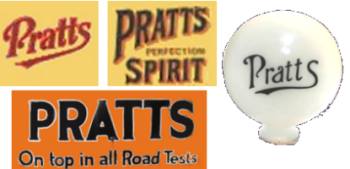
Fig : Pratts logos
The Pratts brand is associated with one of the very few pre-war Class A bogie oil tankers, it was re-painted with the Esso logo in the later 1930s and soldiered on for several years but I do not know if it survived World War Two (the wagon and markings are described in the section on Goods Rolling Stock - Rail Tanks, Esso were always at the forefront of rail tanker use, owning up to a quarter of all the tankers in use at one time). The Pratts Perfection Motor Spirit name continued in use in England until 1935-6 when first Essolube (for oils) then Esso (for petrol) replaced the older brands.

Fig : Esso logos from the later 1930s
The Esso logo was originally just the lettering as shown above, the `Esso' logo with the blue oval was introduced in 1938/39 (hence a lick of paint can back-date a wagon to pre-war livery). The illustration below shows Esso delivery lorries in the 1960s (left) and later 1970s (right).

Fig : Esso lorries in 1960s and 1970s livery
Esso also sold paraffin, in the 1930s they used the Royal Daylight Paraffin brand, changing to Esso Blue after the war. This was a Class A liquid but as far as I am aware the rail tankers were not branded for this traffic.
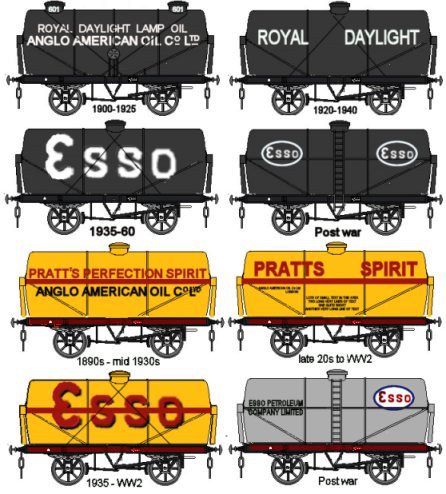
Fig : Esso rail tank wagons showing evolution of liveries
Esso built a large refinery at Fawley on the South Coast in 1949 (there had been a refinery there since 1921 but I am not sure who operated it). Esso became part of the Exxon Corporation in 1978.
Mobil
This was established as the Standard Oil Company of New York, following the 1911 break up of Standard Oil and merged with the Vacuum Oil Corporation in 1931. The company traded in Britain as the Vacuum Oil Co from 1885 selling lubricants under the Mobiloil brand. Their oil blending and grease plant at Birkenhead (set up in 1910, after the warehouse burned down) included a grease plant and blending facilities and it was extensively developed until by 1939 it was one of the largest and most important blending units of its kind in Europe. This was bombed out in the war and rebuilt (lubricants are vital in wartime). Mobiloil was a major brand by the 1930s and in 1953 they purchased an oil storage depot at Coryton on the Thames and built a refinery there (beside the existing Shell refinery at Shell Haven) which came on stream in 1953. They then began selling petrol, originally under the Mobilgas name.
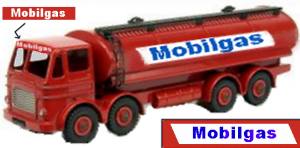
Fig : Mobilgas lorry in 1950s livery
I have found a reference to a 20 ton Class A anchor mounted rail tanker branded Mobil and owned by the Mobil Oil Co.Ltd. built in 1949 but I am not sure when that branding was applied to the wagon. It was in 1963 they changed their name to Mobil, introducing a new logo but still incorporating the flying horse, although Mobiloil continued as their oil brand until the 1970s. Mobil was the first major brand to adopt self service on a large scale in the mid 1960s. In (I think) the later 1980s they changed their logo to just the word Mobil with the 'O' in red and no flying horse. In 1996, Mobil's fuels operations in Europe were placed into a joint venture 70% owned by BP and the Mobil petrol brand disappeared from service stations. Mobil continued to sell lubricants through BP and independent service stations. In 1999 Mobil merged with Exxon and in 2000 BP acquired all the former Mobil petrol retailing assets as well as the Coryton refinery (but sold the refinery to Petroplus in 2007). Mobil returned to being purely a lubricant brand in Europe, and became the premium quality oil on sale at Esso service stations.
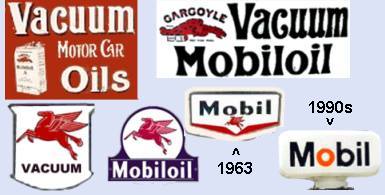
Fig : Mobil signs and pump tops
Around the end of the 19th and early 20th century the British oil industry expanded rapidly, Shell, Russian Petroleum, Anglo-Persian Oil Co, and Anglo Mexican Oil were all set up between 1890 and 1914.
Burmah Oil Company
This was set up in Glasgow in 1896 with the intention of developing oil interests in India. It was an early shareholder in Anglo-Persian Oil Company (APOC) and was the only oil company to operate in Burma until 1963 (when the oil fields were nationalised). Burmah was primarily an oils and petrochemicals company, petrol was always something of a side line. However in the 1960s Burmah began selling via petrol stations under their own brand, in the later 1960s they bought out the Curlew discount chain of stations (which they re branded Burmah) and the Major and Apex chains (which they did not re-brand as these were established firms). I have not yet found any illustrations of pre-1960s Burmah tanks, I assume they had some, the sketch below is based in a rather poor photo taken in the late 1960s or early 1970s I believe.
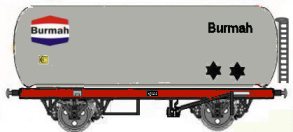
Fig : Burmah Oil tank
In 1966 they purchased Castrol Oil (the main British lubricant manufacturer). Halfords, the motor parts supplier, became a part of the Burmah Oil in 1969, following a takeover battle between Burmah Oil and Smiths Industries (Halfords was sold off again in 1983). In the 1970s Burmah Oil ran into financial difficulties and had to be helped out by the Bank of England, in 2000 the company was bought by BP-Amoco (now BP).
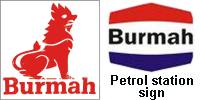
Fig : Burmah Oil - old logo and petrol station sign (introduced in 1969)
APOC & British Petroleum (see also Shell-BP below).
BP is one of the world's largest oil companies and is today (1987) Britain's largest company. BP began life as the Anglo-Persian Oil Company (APOC) in 1909, in 1913 APOC was partially nationalised in order to secure oil supplies for the Royal Navy and in 1917 they purchased a German owned oil distribution company called British Petroleum and established this as their main marketing subsidiary. Hence most road and rail tank wagons were thereafter marked BP rather than APOC. The wagons shown below are both unusual, the twin tank is in standard APOC livery, the two-compartment tank is in early BP livery (although this should I believe be a serif font not plain as shown).
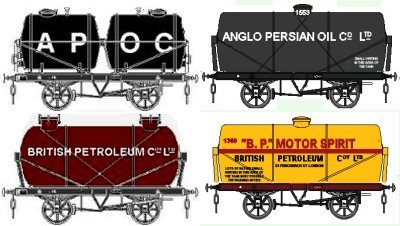
Fig : APOC and early BP liveries
Regarding branding they used B.P. in a plain font but with the full stops on many items, and British Petroleum (in full and in a serif font) was the norm on tank wagons. In 1920, they held a staff competition to design a new logo and came up with the shield design. In 1921 there was at least one Class A wagon branded B.P. MOTOR SPIRIT but I am unsure as to the details of the logo used. I think the flag design (often seen as a tinplate sign in garages) came after the shield as the BP has the inverted commas round it and resembles the lettering used for the shield design.
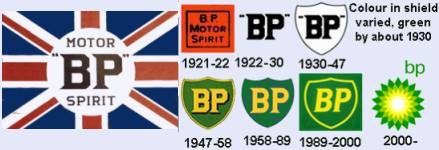
Fig : BP logos
APOC changed its name to the Anglo Iranian Oil Company in 1935 but as far as I am aware the AIOC logo was never used. The name changed again to the British Petroleum Company in 1954. The company was fully developed oil company marketing a wide range of oils as well as petrol. They sold a lot of paraffin under the brand name Aladdin Pink (the name changed after World War Two to Pink Paraffin). The pink dye was added as a safety feature in order to prevent paraffin being mistaken for other liquids. An uncoloured form was sold (much more cheaply) as White May. BP acquired the chemical interests of the Distillers Company 1967 (Distillers group had purchased a small pharmaceuticals company which was doing well on the sales of a new drug called Thalidomide. This drug was then found to cause birth defects, as the new owners Distillers were held liable and had to sell most of their assets to pay the compensation and legal costs. Distillers, one of the countries biggest companies, was dramatically reduced in size).
BP built a large refinery at Coryton on the Thames in 1953 (where there had been a tank farm for imported oil for many years).
From 1932 until the end of 1975 Shell-Mex and BP had an 'Agency Agreement' in which they pooled their distribution network. As of 31 December 1975 BP Oil Limited became the BP group's wholly-owned refining and marketing subsidiary in the United Kingdom.
Shell (see also Shell-BP below)
Shell is an Anglo-Dutch oil-development and exploration concern Royal Dutch/Shell Group, and is one of the world's biggest companies. The business originated in the early 19th century with a curio shop in East London that sold shell ornaments. By the time the railways arrived in 1830 the dealer, Marcus Samuel, had built up an international trade in copra and oriental artefacts. They spotted a hole in the market for oil transportation from the main European supply in Baku (then Russia now Azerbaijan). The Rothchilds had invested heavily in building railways and digging tunnels to get the oil to the coast but a certain Mr Rockefeller (owner of Standard Oil) had monopolised the wooden barrel market (Standard Oil played rough, a bit like Microsoft in the later 20th Century). Mr Samuel and his associates commissioned (in secret) a fleet of oil tanker ships (it had to be in secret or Rockefeller would have seen to it that they failed.) Then oil was found in the Dutch East Indies and they built ships to bring the oil through the Suez canal to Europe. 1897 The Samuel brothers initially called their company The Tank Syndicate dealing in oil and kerosene (paraffin oil) using the name Asiatic Petroleum Company but in 1897 renamed it the Shell Transport and Trading Company. The British owned Shell Transport and Trading Co was then merged with the Royal Dutch Petroleum Company in 1907 becoming one of the worlds first multi-national companies. The company continued to expand and took over the Anglo Mexican Oil Company giving the brand name Shell Mex (this must have been in the early 1900s). The illustration below left is an early Shell Mex pup-top globe. Prior to World War Two Shell was the best selling petrol in the UK. Over the years there have been various changes to the logo as shown below with the date of introduction (they also used a plain red shell symbol on some of their advertising signs).
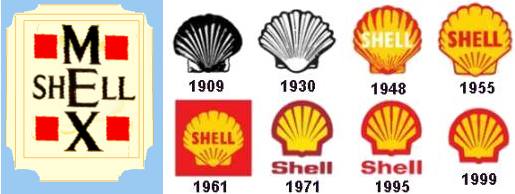
Fig : Shell logos
In 1912 the company built a tank farm at Shell Haven (the name is nothing to do with the company the place was already called that) and refining started at the site in 1916. Prior to 1917 Shell used British Petroleum to distribute their product in the UK, however at that time BP was a German owned company and during World War One this told against the Shell brand, who therefore set up their own in-house distribution network. In 1948 a further expansion at Shell Haven added a 'crude distillation plant' to handle oil from Kuwait (this took two years to build, opening in 1950). The Shell refinery at Stanlow dates back to 1924, when a small bitumen plant was established at the site, bringing in the crude product in rail tankers and shipping out the refined products. The site was built up over the years into a full oil refinery, in the 1970s an oil pipeline was constructed from Amlwch, Anglesey to Stanlow so that large tankers could pump oil ashore for the refinery but rail tank traffic remained a major feature, shipping out the product of the plant. The Anglesey pipeline closed in the 1980s, replaced by a much shorter 15 mile line to the Tranmere Oil Terminal on the River Mersey. Output is delivered by pipeline via the UKOP pipeline, road, rail, and the Manchester Ship Canal.
The Shell business has always made use of rail transport, however the matter of livery seems a little complicated. The examples shown are intended to give some idea of the basic liveries applicable to the stated periods, to assist when selecting a ready-to-run model. However this is a tiny selection and if modelling a wagon you need a good photo (Mr Tourret's book on tanks wagons is a good starting point, see Bibliography)
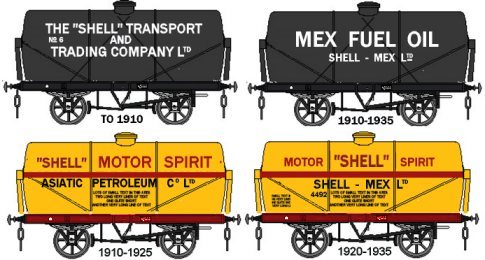
Fig : Shell tanks pre Shell-BP
In 1927 they had at least one triple compartment tank with odd external pipework and a discharge pump on one end marked Shell Lubrication Oil (their number No.2454 1927 and registered on the LMS), this had a very light coloured body with (I think) red lettering. I believe Shell were also behind a company called Lubricant Oil Producers who operated 45 ton tanks in the later 1960s.
Shell is the world's largest oil and gas producer, with the largest oil reserves, and is responsible for 5% of the world's oil and gas production (1987). It has 2,000 operating companies worldwide. It is also the world's largest retailer, with (1994) 40,000 petrol stations in 100 countries. Its sales turnover in 1992 amounted to more than the gross national product of any country except the 23 richest.
Shell-BP
Shell-BP was a joint oil shipping and marketing operation within the UK only, set up in 1932 when the Great Depression hit. The statement released was as follows:
" The Anglo-American Oil Company, the Anglo-Persian Oil Company, the BurmahOil Company, the Mexican and Canadian Eagle Oil Companies, and the Shell group ofcompanies, considering that the present currency difficulties can best be met and mostspeedily brought to a successful conclusion by the closest possible industrial co-operation,have decided to that end to collaborate to the fullest extent in the United Kingdom.They will accordingly develop ways and means to secure that this co-operation will affordthe unhampered supply of the requirements at the lowest possible cost. They hope thatother industries and similar organisations will follow their example. The world is facedwith the most serious crisis in its history, and co-operation amongst the industrialists isthe main factor which must tell in the end in providing the remedy for the world's presenttroubles, because industry provides the only real necessities of life and gold need notplay such an important role".
Originally S.M. & B.P.'s was owned 40% each by Shell and BP and 20% by the Eagle Group but in 1959 the Shell group took over the Eagle group, and their 20% share of ownership.
This joint operation lasted until 1976 when Shell and BP again split their distribution networks. During this period the lorries and railway tanks were marked SHELL-BP. Not all the railway tanks were marked in the joint logo however, the specialised oils were not joined and motor spirit (petrol) tanks remained separate as the two petrols were different The basic livery for Class B tanks is shown below on an elderly rectangular tank (some shell-BP tank in the 1960s dated back to the 1880s).
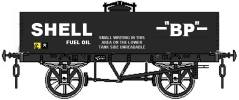
Fig : Shell-BP tank wagon in early livery
There were many variations on the livery, I read somewhere that some class A tanks had the word SHELL (plain lettering in red, not the logo) on one side with BP (in a serif font and green) on the other, both in lettering about three feet high, these would not have been used for petrol (the two brands were different) but may have been used for other Class A liquids. This asymmetric marking was I believe the standard on the road tankers until after the war when the logos were used in place of the names. The picture below is a 1925 Thornycroft with a 600 gallon (2,728 litres) tank (Shell bought six of these in 1925). The illustration based on a tracing of a photo of a restored tanker on show at Hampshire County's collection of rare Thornycroft vehicles at Milestones.

Fig : Shell-BP lorry in early 1932
In about 1955 the road and rail tankers changed to having the company logo's on the sides in place of the names. On the lorries these were at either end of a white rectangle (the tank body was red), in the centre was a red rectangle with the words 'petroleum products'.
![]()
Fig : Mid 1950s to early 1960s Shell-BP lorry markings
In Mr Tourret's book on Petroleum Tank Wagons (see Bibliography) there are photos of Class B tanks bearing variations this sinage, but I am not sure if they ever ran in traffic. The sketch below shows an in-traffic wagon using the new logos. The sketches below are typical for the later 1950s on.

Fig : Shell-BP tank wagons in post war livery
From 1966 the Shell and the BP Service Station networks were managed by separate sales organisations within Shell-Mex and B.P and in 1976 the two companies decided to end their co-operation in the UK distribution market. The road lorries were then re-branded with the individual company livery, although the rail tankers took a lot longer to be brought into line.
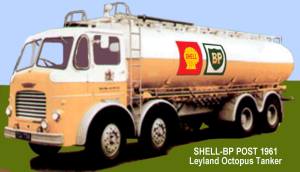
Fig : Shell-BP lorry in early 1960s
Benzole & By-Products Ltd
This company, of Mitcham, Surrey, had some Class A wagons built in the 1920s which were marked as carrying '"B.M." Motor Spirit'.
Carburine Motor Spirit & Glico Petroleum
The Gas Lighting Improvement Co Limited based at West Ham marsh, London was established in 1888. By about 1900 they were selling Carburine motor fuel (derived from coal tar) and operating a small fleet of Class A tankers to carry it, initially branded with the company name above the red line and London below with the number to the left and the 'no naked light' warning to the right, both below the line.

Fig : Carburine enameled sign
By 1914 they were selling 'Carburine' and 'Gilco' motor spirit and motor oils, as well as 'Gilco' turps, benzene, benzolene, benzol and even solvent naphtha for paint and varnish manufacture. In the 1920s they changed the company name to Glico Petroleum, however Carburine was an established brand and remained in use in parallel with Glico (the tank on below right was built several years after the name changed but was still branded Carburine). In the later 1930s they merged with Redline to become Redline-Glico. This company was taken over by Esso in the later 1950s.

Fig : Carburine & Glico tanks
Redline
Originally the Union Petroleum Products Co, selling 'Redline' and 'Ensign' brands of petrol the name changed to Redline Motor Spirit Co in the later 1920s. Early tanks resembled the example shown but had 'redline and ensign' above the central band, the word 'and' being half the height of the other two words, and 'motor spirit' below the band. The plate shown below was on top of one of the early 'iron maiden' type petrol pumps (the subsequent illuminated glas 'globes' were initially the same shape, later changing to round).
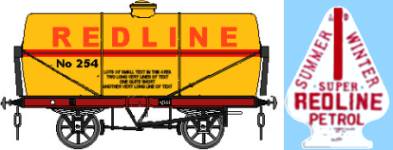
Fig : Redline tank and advertising plate
Following the merger with Glico in the later 1930s the brand above the Class A tank band was Redline Glico and this company was in turn taken over by Esso in the later 1950s. The example livery shown serves from the mid 1920s through to World War Two. The illustration below shows a 1935 Leyland lorry in what I believe was the Redline-Glico road vehicle livery.
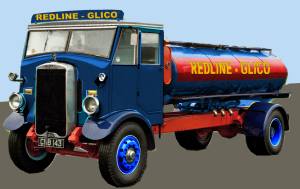
Fig : Redline-Glico road tank livery
National Benzole
This company was formed in 1919, 'Benzole' refers to an additive they employed, derived from coal tar. During the war plants had been set up to recover benzole for explosives manufacture, when the war ended the National Benzole Co. Ltd. was formed as a co-operative selling organisation by the benzole producers. At first they simply sold the benzole for use as an alternative to petrol, motorists liked the product but some preferred to mix it 50/50 with petrol (where it this prevented engine knocking and improved acceleration and smoothness). In 1922 the National Benzole brand (selling the benzole petrol mixture) was set up, obtaining its petrol supplies from B.P.
. National Benzole used a picture of Mercury (they called him Mr Mercury) in advertising and adopted the head (in black and gold) as their logo. The mixture proved to be very popular with British motorists and the National brand became a common sight at the roadside.

Fig : 1950 Austin K4 5 ton lorry in 1950s livery and tank in early 1960s livery
After the war they were the UK's best selling brand but were taken over by Shell-Mex-BP in 1957 (their operation being merged with the Power Petroleum business). During the late 1950s Benzole was found to be hazardous to health and therefore from the early 1960s onwards National only sold petrol, at this time they changed the logo to a 'more modern' yellow blue and white design, although still based on the Mr Mercury head.
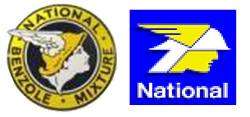
Fig : National Benzole logos
From the later 1980s BP steadily re-branded the 'National' stations as BP, but in 2001 a Scottish firm (Scottish Fuels, formed in 2001 by buying some of BP's local assets in Scotland) licenced the name and for several years there were several stations using it, although the petrol was supplied by BP.
Dominion
This company started in 1923, supplying imported Russian petrol to English filling stations but became a wholly-owned subsidiary of Sealand Petroleum Co. Ltd. when that company was incorporated in 1926 (Sealand was the UK branch of the US company Marland Oil which at the time owned 10 percent of the worlds oil reserves. Marland later became Conoco, re which see below). Sealand was sold off in 1933 to Shell-Mex & BP Ltd, however the Dominion name continued to be used as a discount brand at free stations until 1957. Dominion petrol stations sold Royal tyres (made in Canada I believe). The original Dominion pump globe was a distinctive pyramid topped affair (below left), this was to be replaced in the later 1930s by a more rectangular design, however this does not seem to have caught on and at a lot of stations the old design was shown as an outline drawing on a spherical globe.

Fig : Dominion Petroleum logo and globes
I could not find any reference to a UK refinery owned by either Dominion or Sealand/Marland, nor could I find any reference to either rail or road tank wagons. They may have had both but equally (prior to the takeover by Shell-BP) they may have used hired-in rail tanks and set up distribution arrangements with local hauliers.
Russian Oil Products (R.O.P.)
This was a UK registered independent company set up in 1925 that distributed Russian petrol from the Caspian Sea within the UK during the 1920s and 30s, branded as R.O.P. and also as ZIP for their premium grade petrol. R.O.P. was sold to Regent in 1948. They had no refinery but bought petrol on the 'spot market' via brokers and sold it on to the retailers, usually at below oil company prices. This would entail a simple 'tank farm' close by a port. They had a fleet of both Class A tanks (for petrol) and Class B tanks (for paraffin, marked Kerosene, illustrated in Mr Tourret's book on petroleum tank wagons).

Fig : R.O.P. tanker and pump globes
Power Petroleum
Originally formed as the Medway Oil & Storage Co they operated a refinery on the Isle of Grain cracking imported Russian paraffin. Power Petrol was their distribution business set up in the early 1920s (the company then changed its name to Power Petroleum). They bought their supplies of Russian oil on the spot market and sold this on to retailers. This would entail a simple 'tank farm' close by a port. They were operating tank wagons from the mid 1920s (possibly earlier). They were taken over by the joint Shell-Mex & BP Ltd. distribution organisation in 1934 but the brand continued in use for some time under the new ownership, the sketch below shows pre-war and immediate post-war tank liveries. Their 'logo' in the 1920s and 30s consisted of a raised hand with the word Power on it as shown, they had glass pump globes made in this shape. Post war the globes were a simple flat sided diamond shape with the word Power on them in green (these may have appeared in the later 1930s).

Fig : Power petrol tanks
The illustration below shows the 1950s livery for road tankers (taken from a 1:76 scale Vanguards model) and the post war petrol pump globe design.
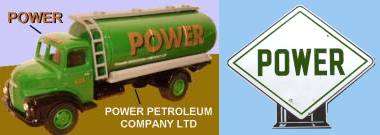
Fig : 1950s Power petroleum road tanker and post war pump globe
Cleveland Oil
Cleveland petrols were formed in 1928 as the Petroleum Storage and Finance Corporation Ltd. to acquire the undertaking of Cleveland Petroleum Products Company and to carry on business as shippers, importers, exporters and distributors of petrol and allied products. They were supplied by ICI with benzol and by Distillers Ltd with alcohol which they blended with petrol, marketing their fuels as Cleveland Motor Spirits and Cleveland Discol Motor Spirit respectively ('Discol' was an abbreviation of Distillers Company Alcohol). I could not find any reference to an refinery owned by Cleveland however by 1938 Anglo-American owned 51 percent of the share capital and in 1954 it acquired a further 37 percent In 1958 Cleveland became its wholly-owned subsidiary of Esso (as it was then called), but the Cleveland name and blended fuels continued in production, trading as the Cleveland Petroleum Products Co. This gave Cleveland five different petrols at a time when many firms had only two or three. In April, 1963 Cleveland had changed the name of its 50/50 Mixture (i.e. a mixture of 50 per cent, standard grade and 50 per cent, premium grade petrol) to Cleveland Premium, but the octane rating (94$) and the retail price (4s. 7d.) remained unchanged. This annoyed Shell and BP as it effectively undercut their own (higher octane) 'Premium' brands. In 1973, Esso chose to end the Cleveland brand and gave up selling benzole or alcohol blends. Cleveland's 2,000 filling stations were switched to the Esso brand. The illustration shows the pre-war logo and what I believe was the post war delivery lorry livery.

Fig : Cleveland pre-war logo and post war lorry livery
Cities Service Oil Co
Set up in 1927 as the British arm of an American company with a refinery in Louisiana. In the 1930s this firm had a fleet of Class A tank wagons carrying their 'Citex Motor Spirit' in the UK which they supplied to independent retailers. Their British arm was bought by Petrofina (of Belgium) in 1953 and re branded Fina. The American company changed their name to CITGO in 1965 and were bought out by Occidental Petroleum in 1982 it is now owned by a Venezuelan company.
Cory Brothers
This company were based in London, they built an oil storage depot (and possibly a refinery) at what is now called Coryton on the Thames. In 1950 they sold the Coryton site to Vacuum Oil Co (Mobil Oil) and ceased selling petrol. They had operated a fleet of Class A tanks in the 1920s and 30s branded Corys Motor Spirit and Class B tanks branded Corys Fuel Oil.
This firm started life as a coal merchant on the grand scale, Cory Bros mines in Wales supplied coal to ships coaling stations around the world. They were at one time the owner of the largest private owner wagon fleet in the UK (mostly coal wagons, the tank fleet was never very large). In 1942 the company was bought by the Powell Duffryn Group, but maintained its identity, In the 1960s Cory's were a distributor for Shell-BP domestic heating oils (a business they stayed with until the 1980s). The tankers were branded Shell-BP but had the Cory logo on the cab doors (illustrated above under 'Distribution Centres and goods-yard retailers')and in the later 1960s they were involved with Hovermarine, a hovercraft company. They operated ;shipping agents' in many ports (I know this company well as they were one of the shipping agents used by the P&O). In 1972 W.M. Cory & Son was bought out by the Ocean Group (an international shipping and distribution company). In the 1980s they closed down the oil distribution business. The Coryton district of Cardiff is named after Sir Herbert Cory, one of the brothers of the title.
Fina
This is the British arm of the Belgian company Petrofina, they started trading in the UK in the later 1940s but only established a British retail brand in 1953 when the bought out Cities Service Oil Company Ltd. (an existing distributor of petroleum products) and several small distribution chains. Fina ware themselves bought out by Total in 1999.
Fina were buying and using railway tank wagons in their livery by the later 1950s (some of which were second hand stock). They have operated rail tankers, both Class A and B, in their livery. In the early years the Class A tanks were silver or very light grey with the word FINA about 30 inches (75cm) high on the upper side in red outlined in black. Under this was 'motor spirit' in black. The Class B tanks used the company logo, usually to the left and with 'fuel oil' in lettering about a foot high on the right.
The illustration below shows the early logo (left, still in use in 1958) and the more recent logo (right, in use by 1964).

Fig : Fina tank logos and petrol pump globe
By the later 1960s newer Class A tanks were dove grey and carried the standard Fina 'shield' logo to the left end of the tank, however I believe some of the new tanks used the old Class A livery (as seen on the Peco model below). The company used both 45 ton tanks and 100 ton bogie tanks in the new dove grey livery. The the 100 tonner livery was sketched from a photo taken in the late 1970s

Fig : Fina Class A tank markings
Total
This is a French company (a subsidiary of Compagnie Francaise des Petroles), Total was incorporated in the UK in 1955, started selling in the retail market in 1958 and began using rail tanks in 1968 to transport fuel imported from French refineries. Initially the UK business sold their product only to independent filling stations but from 1960 began buying their own petrol stations which they leased to tenants. Their (leased) Class B 100 ton bogie tankers were as shown below in the early 1980s, later in that decade they leased some four wheelers as shown below right.

Fig : 1980s leased tanks in Total livery
TOTAL operates two refineries in the UK, Lindsey Oil Refinery in Immingham (shown on the map as Killinghome and jointly owned with Fina plc.) and Milford Haven Refinery in West Wales.
Regent
This company appeared in the 1920s as and independent petrol station chain (no refineries they were just a distributor), they were purchased in 1930 by the Trinidad Oil Company to sell their (imported) products in the UK. They had a number of tank wagons during this period but I am unsure as to their livery (they bought some in Class A tanks 1942). The Regent Oil Company was formed in the United Kingdom in 1947 as a joint operation between the Texas Oil Co (Texaco Petroleum Products - see Texaco below) and the Trinidad Leaseholds Company. Texaco was an American petroleum company that had been operating in the United Kingdom since 1916. During the 1950s, Regent began to expand its operations, including selling branded petrol in the UK as well as shipping and refining ventures abroad. They operated large (for the time) tankers using ports such as Gloucester. Regent was then completely taken over by Texas Oil (Texaco) in 1956 but was then run as a joint operation by the US companies Texaco and Chevron until 1967. One retailer in 1956 displayed the notice: " Sold!—Regent to America together with the independence of thousands of British garages ". Texaco opened its Pembroke Refinery in South Wales in 1964.

Fig : Regent tanks
In 1967 the joint Texaco Chevron operation was wound up and after that date Texaco began replacing the Regent brand with the Texaco name. However, in 2004 the Regent brand name was reintroduced as Texaco consolidated some of its smaller brands under one name that would be familiar to UK customers.
The illustration below left is based on a Corgi model of a tanker in Regent livery, I believe the livery dates from the 1950s, the illustration on the right is based on the Vanguards 1:76 model and (I believe) shows the later livery.

Fig : Regent lorries in the 1950s and 60s
The picture below left is from a Regent ad from 1963, the lorry is delivering lubricating oils to a ship (hence the two ships officers). To the right are the original square and oddly shaped Regent pump glove and the later (late 1950s) design.

Fig : Regent lorry delivering lubricating oil in 1963 and pump globes
Regent stations sold Havoline lubricating oils (owned by Texaco) branded as 'A Regent Product' and their 'own' brand of paraffin, branded 'Super Green'.
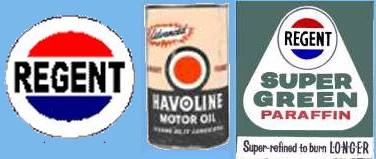
Fig : Regent logo, Havoline Oil (a Regent product) and paraffin sign
Jet
This company was established in 1953, owned by and supplying a group of commercial vehicle owners. They started selling to other haulage firms, buying their fuel from Regent (Jet has never owned a refinery, it is an oil dealer). Jet then started building ocean terminals with large tank farms to take imported oil, mainly from Germany.
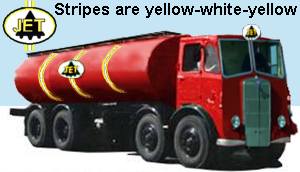
Fig : Jet's first lorry in the 1950s
In 1958 Jet entered the retail market, selling via independent petrol stations to the general public. A survey carried out by Jet at this time showed that about 7 per cent of all retailers in the United Kingdom were free of solus ties. At first Jet followed the price levels of the larger companies, but in early 1960 it adopted the policy of lower prices and lower retail margins (with the expectation of increased turnover). One thing that helped was that the octane rating of its petrol was higher than that sold by the other companies.
Jet initially painted their lorries all-over red, the first example has the stripes shown above but later trucks were plain red. The logo changed to the yellow box with black JET in the later 1950s, the white lettering on the tank says Jet Petroleum Ltd.
In June, 1961 Jet became a subsidiary of Continental Oil Company of Delaware (better known as Conoco, and since 2002 as ConocoPhillips), described by Jet as a 'big independent' with 'abundant sources of Libyan crude oil'. It was the intention that Jet should market this oil after it had been processed in German or Italian refineries run by Conoco. In the same year Jet purchased its first petrol station and introduced its first solus agreements. The company continued through difficult times, in the 1980s it expanded a bit then in 2001 it sold all its outlets, although it still supplies them with petrol.

Fig : Jet commercial tanker and distributors tanker in 2009
Images copyright and courtesy of ConocoPhillips
Lobitos Oilfields Ltd
This company was formed in 1908 to operate oil concessions in Peru, SouthAmerica. Lobitos had its own refinery capacity in theUnited Kingdom but its main business was as an independent supplier in South America. Its main interest in Britain was the production of specialty products(white oils, transformer and cable oils and bitumen); petrol was produced onlyas an unavoidable by-product which the company supplied to retailers, commercialcustomers and ex-tank buyers.
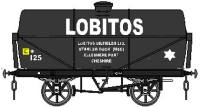
Fig : Lobitos tank wagon
In 1962 they became a subsidiary of Burma Oil Co. but continued selling under their own brand. In 1964 the company'ssales of petrol amounted to 12 million gallons. Nearly 80 per cent,of this total was supplied to the retail market, about 70 per cent of it inNorthern Ireland where about half of the nearly 300 retailers marketing itspetrol had entered into solus arrangements. In England, on the other hand,most of the petrol sold was to retailers without solus arrangements. Lobitosalso owned a few petrol stations in the later 1950s and 1960s, branded Lobitos, which they set up because the solus schemes were killing the independent retailer market. The picture below is from a 1967 advert for Thornycroft lorries, the inset shows the Lobitos logo. Their railway did not use the logo (as far as I am aware).
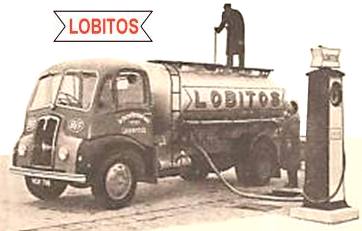
Fig : Lobitos branding (used at petrol stations)
Berry Wiggins & Co
Established an oil refinery at Kingsnorth on the Hoo peninsular in Kent in 1930, accessed via a single line gated branch from the nearby Southern Railway line which ran as a three line set of long loops before serving numerous sidings in the works. This firm also operated a site at Weaste (near Manchester). This firm operated a large fleet of both Class A and Class B tank wagons, some of the latter being for bitumen and marked "Liquaphalt" in a yellowish roundel. Their Class A tankers had a similar logo design but with Kingsnorth Petroleum inside the roundel.

Fig : Berry Wiggins & Co branding for Class B (left) and Class A (right)
The Berry Wiggins complex ceased to refine oil in 1977, and refining at the comparatively newer BP Isle of Grain complex (built in 1951) also stopped in 1982. Subsequently, oil was shipped into the country in an already refined state, but deliveries were still made to the Isle of Grain thereafter, the last oil train not departing until 1999.
Butlers Chemicals Ltd.
This company started life as a tar distillers (for details of that operation see under Lineside Industries - Coal and Wood Tar Distillers). In 1903, William Butler & Co (Bristol) Ltd formed a subsidiary called The British Refined MotorSpirit Co. selling benzole from a distillation plant purchased in the 1890s. Butlers pulled out of the tar distilling business in 1962, by 1965 they had transferred everything to their oil products plant centered on the new Rockingham Works at Avonmouth where they operated under the name of Butlers Chemicals Ltd. In 1972 the name changed again, to Butlers Oil Products, by which time there were Butlers branded petrol stations. The company was taken over by Fina in 1988, and then Total Oil in 2001 and as of 2008 it is still trading as Total-Butler supplying fuel oils. Total Butler holds a royal warrant for fuel oil supplies but as far as I am aware this company distributes only by road haulage from the Avonmouth plant (but I may be wrong on that).
Sinclair Union Petroleum Co
This was an American firm who started trading in the UK about the time of the First World War, I do not believe this firm operated a UK refinery but I understand it did operate a number of Class B tanks carrying lubricants (sold under the Sintex brand) from the 1920s on and I believe in the 1930s they had some Class A tanks carrying paraffin (but marked 'Kerosene'). They were very big in Belgium from the 1920s (and are still there today) and I believe they may have sold their Opaline brand lubricating oils through UK garages in the 1940s. In 1968 they bought out ABCO Ltd, a petroleum oil brokers who, trading as Arthur Brown and Company, had been one of the first importers of Russian oil after World War One. In the 1960s they bought out the small independent Abco and Gainsborough chains of service stations, and so may have operated some petrol tankers at that time, but that operation was in turn bought our by AtlanticRichfield Company (ARCO) in 1969.
Western Refining and Marketing Co
Another American firm, based in Texas I believe, and listed in America as Western Refining. They (or someone using this name) operated a small fleet of Class A tanks in the UK at some point (pre World War Two), the logo from which is shown below, beyond which I have no details.

Fig : Western Refining and Marketing Co tank logo
Post 1960s British Petrol Company Names
During the 1960s, Britain was a booming market and many oil companies set up a UK based distribution system. Most did not last although Total, Conoco and Murco, who all arrived at this time, are still operating their own chains of service stations.
V.I.P.
This was a brand introduced in 1960 by a distributor called Isherwoods Petrol Company. Isherwoods was established in 1934 as a wholesale distributor of petrol and other oil products (their tanker lorries had SUPER in (I think) red on a white rectangle with Petrol to one side) and the company details confined to the cab doors. Isherwoods owned and operated a small chain of petrol stations and a fleet of road tankers and purchased bulk supplies of petrol (both imported and from British refineries) both for its own stations and for sale to other retailers and to commercial consumers. In 1951 a new company was formed to hold and operate the chain of stations leaving Isherwoods to concentrate on wholesale distribution, originally in the Manchester area.
When the solus system was introduced Isherwoods lost most of its retail customers (although sales to commercial users remained). In 1960 the company introduced its V.I.P. brand petrol, pitching the price to compete with the likes of Jet. Towards the end of 1963, following a minor price war amongst the big companies it was able to take over the interests of two smaller wholesale distributors, Octane Petroleum Co. Ltd. and Orbit Petroleum Ltd.. These companies operated in the London area and inYorkshire respectively, where their brands were sold at prices lower than those of theleading petrol companies. The company acquired ocean terminals and inland storage depots so it could import petrol at a lower price than it could buy it in the UK. In 1964 Signal Oil & Gas Company of California, the main supplier for the firm, bought out Isherwoods but retained the brand and the UK management. In in 1968 the brand was purchased by Occidental Oil (who built an oil refinery at Flotta in the Orkney Islands in 1976).

Fig : VIP branded tank wagon
Occidental Oil continued using the VIP brand but also introduced their own Oxy petrol brand at some stations. These brands were seen on road tankers and the VIP brand was also seen on rail tanks in the 1970s, but the Oxy brand was not used (as far as I know) on rail tanks.

Fig : VIP and Oxy logos
I have not traced any reference to Oxy branded tank wagons in the UK. In the mid 1970s the service stations were sold to Elf. I believe the V.I.P. and Oxy petrol brands had disappeared by the early 1970s.
Amoco
This was an American Oil Company, also known as also known as Standard Oil of Indiana after 1925, who entered the British market in 1964, from when they operated rail tank wagons. Amoco had a large refinery at Milford Haven which came on stream in 1973, the wagon below is both lagged and steam coiled, suggesting it was used for bitumen traffic.
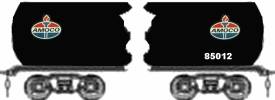
Fig : Lagged Amoco tank in the 1970s
In 1981 Murco purchased a 30 percent share in the refinery and Amoco sold the rest to Elf in 1990 (I believe Murco are to buy out the Elf stake in 2008). In 1957 all the divisions of Amoco were consolidated into a single company, renamed the Amoco Corporation in 1985. In 1998 Amoco merged with BP to form BP Amoco, now known as BP. The sign below was photographed in the 1980s at an Amoco station.

Fig : Amoco
Murco
This company was established as a UK company in 1960 (as the British arm of the US oil company Murphy Oil) Murco entered the British market in 1962 by buying two small British chains EP (European Petroleum) and Olympic. Olympic was phased out by about 1970 but some EP branded stations remained. Initially they purchased an oil terminal at Grays in Essex, allowing them to tanker in their own fuel, they hired in 45 ton 4 wheelers for this traffic but these were not branded. This was followed by the development of rail fed terminals at Bedworth, Warwickshire and Theale, Berkshire to supply the expanding Murco and EP service station chains. In 1981 the company took an effective 30% interest in the (then Amoco now Elf) oil refinery in Milford Haven, Wales allowing them to refine their own North Sea Oil supplies. In 1990 the final link in the supply chain was added with the opening of the Westerleigh terminal near Bristol. The sketch below shows the livery on some bogie tankers operating in the 1990s.

Fig : Murco rail tanker in the 1990s and detail of logo
In 1981 Murco expanded its UK operations with the purchase of 30% of Amoco UK’s Milford Haven Refinery. In December 2007 Murco purchased the remaining 70% interest in the refinery to become the 100% owner. Murco owns and operates three storage and distribution terminals within the U.K all of which receive product by rail. The terminals are located in Bedworth, Theale and Westerleigh. The illustration is based on a photograph taken from promotional literature.
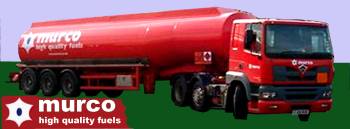
Fig : Murco road tanker in 2007
Although a small company by comparison to others in the field Murco has managed to survive and thrive by reacting quickly and effectively to the ever changing market conditions. Today Murco supply over 160 company owned and 260 independently owned service stations in addition to a growing number of commercial customers. Being an independent company the benefits of rail transportation outweigh the costs of pipeline building so rail deliveries remain in use in 2007. At some point I believe they merged with Amoco and the petrol stations were branded as Amoco but I am very unsure on this.
ICI (Imperial Chemical Industries Ltd.)
ICI manufactured petrol from coal and after 1939 from creosote on Teesside from 1935, and continued to do so up to about 1950 (operating a number of Class A four wheeled tanks with ICI in red on the sides). In the early 1960s they were producing naphtha at their oil refinery Billingham, the petrol was a by-product of this process and they started a small chain of petrol stations branded Imperial in the mid 1960s. By 1970 these were branded ICI. The chain was sold to Burmah in 1987.
At some point (I think the early 1960s) ICI went into partnership with Phillips Oil to form Phillips Imperial and further investment in refining was injected, in September 1966 a second distillation unit came on stream which added 4 million tonnes a year to the existing annual capacity of 1 million tonnes from the refinery at the North Tees Works of ICI in Cleveland. The 4 million tonne unit was the first major refinery to be built in the North East England and the first in Britain constructed specially to use North African crudes. ICI consumed the naphtha and some fuel oil from the refinery, the remaining products, kerosene, diesel, gas oil and fuel oil were sold by Phillips Petroleum Products Ltd (sole agents for PIP) who did use some rail tanks (as well as road and seabourne tankers and a pipeline. I believe however thatICI sold its own refinery in 2000 (to Huntsman Corporation) and it's share of the joint Phillips Imperial refinery to Petroplus in 2001.
In the 1930s ICI had some Class A 14 ton tanks marked 'Imperial Chemical Industries Limited' on the upper sides and 'Synthetic ammonia & nitrates limited' on the lower sides below the red band. Photographs of both may be found on the Stockton on tees local picture website ( http://picture.stockton.gov.uk/photos/t821.aspx ). For rail traffic in the 1960s they used hired tank wagons until the early 1970s, after which they operated some tanks themselves, some of which carried their logo.

Fig : ICI logo
Texaco
The Texaco Petroleum Products Company first began marketing fuel and lubricants in the UK in 1916, notably offering the Havolene lubricant brand (originally a 'wax free' petroleum based oil, which they had bought in 1909). It operated a joint distribution system with Standard Oil of California (later Chevron) from the mid 1930s supposedly using the brand name Caltex but in Britain the joint operation used the brand Regent from 1947 (Regent was an existing British independent distributor, see above). They purchased Regent Oil outright in 1956. The illustration below shows a Texaco on 1950s livery, based on the Vanguard Models 1:76 model.
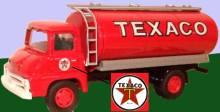
Texaco opened its Milford Haven refinery in 1964 (their only UK refinery) and was one of the last
Fig : 1950s Texaco tanker
companies to operate the original 35 ton 4 wheel anchor mounted tanks. Caltex was wound up in 1965, at which point the Regent brand was absorbed by Texaco. Texaco merged with Chevron Oil in 2001. The illustration shows the logo used in the 1930s (left) and the post war logo (sometimes used on petrol station signs which changed to the Texaco brand after 1967), the logo on the right is used on petrol stations (after 1967) and on the road and rail tanks.
Fig : Texaco logo
In 2001 Chevron and Texaco merged to form a new company called Chevron Texaco.
Chevron
Originally Standard Oil of California, became a separate company with the break up of Standard Oil in 1911. It operated a joint distribution system with Standard Oil of California (later Chevron) from the mid 1930s supposedly using the brand name Caltex but in Britain the joint operation used the brand Regent from 1947 (Regent was an existing British independent distributor, see above). The Chevron brand first appeared in the UK in 1967 following the end of the Chevron-Texaco joint operation under the Regent banner. In the 1980s the company decided to concentrate its activities in the US, I believe they sold their remaining British interests to Texaco in 1984. In 2001 Chevron and Texaco merged to form a new company called Chevron Texaco.

Fig : Chevron logo & 100T Tank
Gulf Oil
This was a major global oil company from the 1900s to the 1980s. The eighth-largest American manufacturing company in 1941 and the ninth-largest in 1979. Gulf Oil had operated in the UK since at least the 1920s (in 1929 Silvertown Lubricants on the Thames near London was acquired by the Gulf Oil Corporation, and in 1950 its name was changed to Gulf Oil (Great Britain) Ltd.) As a petrol station brand however Gulf first appeared in Britain in 1962, their first tanks were some second hand fuel oil anchor mounted tanks but were painted blue with orange lettering.

Fig : Early Gulf tanks
The Gulf Oil Refinery at Milford Haven operated from the mid-1960s until 1997, when refining operations ceased and the outlets were sold to Shell.By the mid 1970s they were using their logo in place of the word GULF, this was applied to some 100 ton Class A and Class B tanks, positioned toward the ladder end in both cases.

Fig : Gulf 100 ton tanks
The petrol was branded No-nox and Good-Gulf. The Gulf company was taken over by Chevron in 1984 but the Gulf brand was then sold to the Hinduja family and since 1999 the brand has been licenced to a number of smaller companies in Europe including in the UK (although obviously none of the Gulf-branded petrol now sold in the UK actually comes from a Gulf refinery). The illustration shows what I believe to be the 1960s livery for lorries (this may be in error it was taken from a restored lorry) and the Gluf logo.

Fig : Gulf lorry and logo
Another wholly-owned subsidiary, Continental Oil (U.K.) Ltd., entered the UnitedKingdom market in 1963. It operates solus arrangements, its petrol being marketed atprices similar to those of the leading suppliers.
Conoco
Continental Oil (UK) Ltd, a wholly-owned subsidiary of Continental Oil Corp of the USA Conoco was taken over by Marland Oil Co who ran the UK based Dominion distribution company in the 1930s, the Marland triangle logo was retained but the Conoco name was used as it was an established brand. Conoco began operating branded stations in the UK in the 1960s after discovering an oil field in Libya, and built the Humber Refinery, South Killingholme (opened in 1969). In 1961 they bought the Jet chain but retained the brand, which had a loyal following. By the later 1960s Conoco was operating both 4-wheel 45 ton tanks and also 100 ton bogie tanks (the latter operated as block trains of 18 wagons). In 2002 Conoco merged with Phillips Petroleum. The triangular logo was in use in the 1950s, replaced by the oval type upper right at some point, then by the joint ConocoPhillips logo.

Fig : Conoco logos
In the 1970s Conoco leased some 20 foot wheelbase 50 ton four wheelers from Procor, these were slightly unusual in design but as a challenge you could fabricate something rather similar by cutting down a pair of Peco tank wagons, although this does leave you with two short ends. There is a drawing and several photographs in Mr Tourret's book on Petroleum Railtanks (see bibliography), the sketch below shows the livery in the later 1970s.
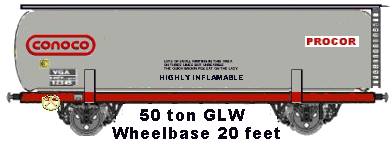
Fig : Conoco leased 50 ton tanker
Agip
Azienda Generale Italiana Petroli was established in 1926 is an Italian automotive gasoline and diesel retailer. It was a subsidiary of multinational petroleum company Eni. Agip entered the British market in 1963 but I was not able to find a reference to a UK refinery. In 1966 the British operation was bought out by Esso.
Tenneco
This was an American conglomerate that started life as the Tennessee Gas Company and diversified into a range of industries, including the oil business. They entered the UK retail petrol market by buying the existing Globe and Golden outlets but I believe they sold the chain of outlets to Jet in the early 1980s. I do not believe they had a refinery in the UK and I have not traced any references to tank wagons in their livery. In 1971 they bought into the chemicals giant Albright and Wilson, and by 1978 they owned the whole company. Albright and Wilson which retained its identity and management until 1995 when it was sold off as a part of the break-up of Tenneco (see also 'Lineside Industries - Chemicals, salt and plastics industries' for more on Albright & Wilson).
Nafta
This was a company from the Soviet Union who arrived in the mid 1960s. They sold their chain to Q8 in 1987. I believe they imported their products from Russian refineries.
![]()
Fig : NAFTA logo
Atlantic Petroleum
This company arrived in the UK in the 1960s, became part of ARCO in 1968, sold its British network to Total by 1970. I believe this was just a distributor with no UK refineries.

Fig : Atlantic logo
Elf
This is a French company, purchased Occidental's British VIP and OXY chains in 1974 and about that time merged with another big French firm but the Elf brand remained. Purchased Amoco and Heron chains in the UK in the later 1970s (I believe). Purchased a 70 percent share in the Milford Haven Refinery from Amoco in 1990. Merged with Total in 2000 (new firm called TotalFinaElf, but that was never a brand). Elf name was gone by about 2003 but the new company retained a 70 percent interest in the Milford Haven Refinery, this is (I believe) to be sold to Murco in 2008). Elf have definitely operated rail tanks in the UK, including 45 ton four wheelers and 100 ton bogie types, as I understand it the 100 ton tanks were leased and had the Elf logo toward the ladder end of the tank on both sides.

Fig : Elf logo
Paul Bartlett's fotopic site has several pictures of leased BRT wagons, see Appendix Seven - Photo Sites for a link to Paul's pages.
Ultramar
A British oil exploration company who, in the mid 1960s began selling petrol, they ended up with a small chain of stations branded Ultramar, these changed to Arco in about 1970. I do not believe either of these names appeared on rail tankers although they may have used branded road tank lorries.
Repsol YPF, S.A.
Repsol (Refinería Española de Petróleo, Sociedad Limitada or Spain Petroleum Refinery) is a newcomer, incorporated in 1986. Repsol is an integrated oil and gas company engaged in all aspects of the petroleum business, they have refineries in four countries and distribution and marketing activities in 12 countries. They have five refineries in Spain and four refineries in Latin America (Argentina and Peru) and interests in another three jointly operated refineries.
Bitumen-related firms
The listed firms have all operated tank wagons for the transport of bitumen at some point. The list is not comprehensive but I have tried to include examples from various parts of the country. The railway tanks were usually insulated and often steam-heated (so would travel next to the engine in transit). An alternative was to fit 'flame tubes' into the wagon into which a gas 'lance' could be inserted to melt the bitumen so it could be discharged. Steam heated wagons have a steam pipe (some had visible pipework at the ends) and would often travel attached to the engine so they could use the steam to keep the cargo liquid, those using the gas lance had holes low down at one end and a chimney somewhere at the top.
Road lorries seem to have been less insulated, perhaps they were only used for short hauls. The example shown below is a beautifully restored 1929 Scammel tanker photographed at a show. I am not sure if the livery is applicable but having done such a lovely job on the restoration it seems likely they took the trouble to get this right. The lorry has a chain drive and note that there are four wheels under the rear of the trailer, arranged in line across. The scene was rather cluttered so I had to cut the lorry out of the picture and provide a plain background.
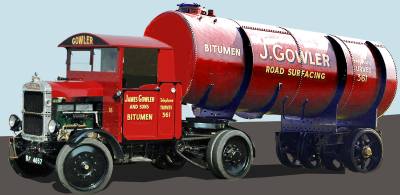
Alexandra Transport of Glasgow
Fig : Restored 1929 Scammel tanker lorry.
This company operated some 13 ton insulated and heated rail tanks built in the 1930s.
Ebano Oil Co
On the other side of Scotland at Grangemouth was the Ebano Oil Co, who imported Mexican bitumen. They were using rail tank wagons from the early 1930s.
Anglo American Oil Co
This company was known as Royal Daylight prior to the mid 1930s and Esso thereafter is actually the UK branch of Standard Oil. Anglo American changed their company name to Esso in 1951 (their railway wagons had been so marked since the mid 1930s)and Esso became part of the Exxon Corporation in 1978. They used the name Standard Bitumen on at least some of their bitumen wagons prior to the mid 1930s. After that date the livery changed to the Esso logo but with bitumen under this on the left hand end. This company trades all over the UK.
Shell-BP
The Anglo Persian Oil Co was operating from 1909, they took over a smaller firm called British Petroleum in 1917 and began using British Petroleum (or BP) as their brand. In 1932 they began a joint distribution operation with Shell, the Shell-BP operation was very wide ranging, covering most if not all aspects of the petroleum trade, they purchased some anchor mounted 14 ton bitumen rail tankers in 1942, branded MEXPHALTE (the Shell name for their bitumen product, in the 1940s they also sold stuff called Shellphalt).
Berry Wiggins & Co
The company produced bitumen from a plant at Sharnel Street on the Isle of Grain as early as 1924 and built their own oil refinery at Kingsnorth on the Hoo peninsular in Kent in 1930. I gather their bitumen tank wagons did not appear until the later 1930s, these often marked "Liquaphalt" in a yellowish roundel (this was their trade name for liquid asphalt, or bitumen). The Kingsnorth refinery closed in 1977.
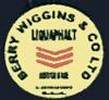
Fig : Berry Wiggins & Co Liquaphalt branding
William Briggs & Sons Ltd
This company (based in Dundee) dealt in fuel oil and bitumen. They operated railway tank wagons from the early 20th century (certainly by 1909, possibly earlier), two of which have been restored by the Scottish Railway preservation Society. I am not certain but I suspect these were for coal tar and its products. They built their own 'refinery' in Dundee in 1931 adjacent to Dundee Gas Works, initially intended to process the coal tar produced at the gas works but subsequently switched to recovering the more valuable fractions from bitumen. By the later 1960s Briggs was the only oil refinery in Scotland outside the Grangemouth complex (Grangemouth was established as Scottish Oils in 1924 by APOC, BP sold off all its petrochemical interests in 2005, the Grangemouth refinery going to INEOS, a privately-owned chemicals company). The Briggs Dundee refinery was sold to Tarmac in 1968, meanwhile however Briggs seem to have continued to operate a fleet of rail tank wagons, it may simply be that Tarmac did not repaint the wagons. On Paul Bartlett's fotopic site (see Appendix Seven - Links to Useful Websites - Photo Sites) there are pictures of some older four wheelers (some dating back to the 1920s) still operating in 1977 in Briggs livery. I believe Briggs are still in existence but serving the shipping world with their main business being Briggs Marine. In the 1920s the tanks as built had William Briggs & Sons Ltd in capitals along the side, with the wagon number below, by the post war era this had changed to the livery shown below, but I do not know when that change occurred.
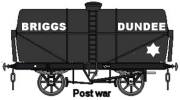
Fig : Briggs tank
Lobitos Oilfields Ltd
This company was formed in 1908 to operate oil concessions in Peru, South America. Lobitos had its own refinery capacity in the United Kingdom where its main interest was the production of specialty products (white oils, transformer and cable oils and bitumen). The petrol from the refinery was an unavoidable by-product which the company sold to other firms. In 1962 they became a subsidiary of Burma Oil Co. but continued selling under their own brand.

Fig : Lobitos tank wagon
Tarmac
Tarmac was formed in 1903 as The TarMacadam Syndicate, the name changed to Tarmac in 1905. In the early days the tarred chippings were routinely shipped by rail, but from the 1930s they began to favour road transport. In 1935 the company began switched from using Sentinel Steam Wagons to lighter motor lorries for deliveries. The photo below was taken at a show. Tarmac marked both their road vehicles and rail transport with the name tarmac, in yellow capitals. This was normally in a plain block script but on the steam lorry fronts this was stretched upwards as shown below.
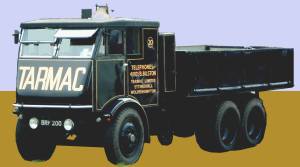
Fig : Tarmac steam lorry
On rail tanks the logo was at a slight angle, rising to the right. In 1964 The 7 T's symbol of Tarmac was introduced and the company name changed to mixed case, capital T with lowercase 'armac'. The railway tanks were not repainted however and soldiered on in their old logo for years thereafter. Tarmac had been operating rail tank wagons since the 1920s, these were steam coil fitted tanks, all black with TARMAC in 3 foot letters at a slight angle (rising to the right) on the sides.
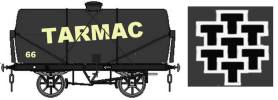
Fig : Tarmac tank and post 1964 logo for lorries
The Briggs Dundee refinery was bought by Tarmac in 1968, however the rail tanks remained in Briggs livery into the early 1980s. The Dundee refinery throughput was increased five fold by 1989. In 1992 the Dundee refinery was sold to the specialist Swedish refiner Nynas Petroleum Group (who also operate from Ellesmere Port). The refinery now processes extra heavy crude oils to produce a range of bitumens and a range of distillates including gas oil, marine diesel, lubricating oil base stocks and fuel oils are also produced.
Foster Yeoman, familiar today for their use of high capacity wagons, were also involved in shipping 'tarred macadam' by rail, however I have not traced an reference to tank wagons in this firm's livery.
Firms Dealing in Bitumen Emulsions
Bitumen Emulsions are fine particles of bitumen suspended in water, used for road surfacing as the water allows the normally very viscous bitumen to be sprayed onto a road surface with less heating, the water then evaporates. The secret to keeping the oily tar suspended in the emulsion is to electrostatically charge the bitumen particles so they repel each other and do not coagulate. This technique, called Cold Spray, was invented at the beginning of the 1920s by Hugh Allan Mackay and George Samuel Illay (a patent was granted in 1922). By then, Mackay had formed his own company, Asphalt Cold Mix Limited, to exploit the patent in the United Kingdom. I was not able to find any reference to wagons owned by Mr Mackay's company.
British Bitumen Emulsions Ltd
This company sold an emulsion mix they called Colfix Emulsion. There is a photograph of one of their wagons in Mr Tourret's book 'Petroleum Rail Tank Wagons of Britain' showing one of their tanks, a two-compartment affair secured at either end by angled plates, the side plating extends beyond the tank ends (sometimes seen on insulated wagons although not common), making this a moderately easy tank to model using a printed paper wrapper.
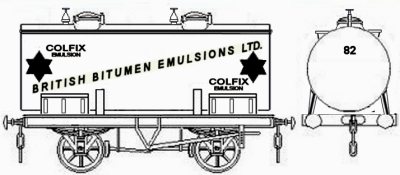
Fig : British Bitumen Emulsions Ltd twin tank
Lion Emulsions Ltd
This company were operating tank wagons by the mid 1930s (possibly earlier) and were one of the last companies to operate a fleet of smaller tanks (most apparently second hand). Some of their anchor mounted tanks continued in use into the 1980s (although the Lion Emulsions branding seems to have disappeared in the 80's, the tanks then being black with just the standard markings and twin traffic stars on them).
Colas
The French firm Colas was formed in 1924 and purchased the exclusive rights to use the product in France. The name Colas (for 'cold asphalt') was adopted because even then other firms were selling their own 'cold spray' products and the term was no longer only associated with the Mackay-Illay product. This company also operated in the UK, they had at least one tank wagon built in the later 1920s however the only photograph I have seen was in Mr Tourret's book Petroleum Rail Tank Wagons of Britain (see Bibliography), this appears to be a maker's photo and there are no markings on the tank body other than the company name.
Viamuls Ltd
Operated leased tank wagons in their 'Bitumuls' livery in the 1920s and 1930s, the example below is from the Bachman Farish N gauge range.
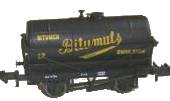
Fig : Bachman Farish 'Bitumuls' tank
Scientific Roads Ltd
Based in Shipley (Yorkshire) and established in about 1930, this company called its product 'Bitrin', the wagons were black with the product name with the company name underneath in white. There is a goof photograph of one of the wagons in Bill Hudson's Private Owner Wagons Vol. 3.
| ^ Go to top of page |
International Good Guys ~ Making the world a better place since 1971
All material Copyright © Mike Smith 2003 unless otherwise credited